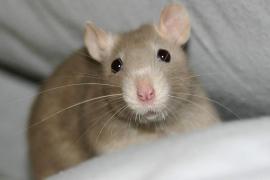Rat-Bite Fever and Pet Rats: How Concerned Should We Be?

Rat-Bite Fever and Pet Rats: How Concerned Should We Be?
The recent report of a 10-year-old boy that died from rat-bite fever in San Diego has raised concerns about the risk of contracting this disease from pet rats. The family of the child is suing Petco, where they bought a pet rat two weeks before the boy died after a 48-hour illness characterized by flu-like symptoms. This incident has brought into discussion the rare but real risk of this zoonotic disease, which is caused by two different bacteria that are carried by rats. The type of rat-bite fever that is most common in North America is caused by Streptobacillus moniliformis. Another form of rat-bite fever is caused by Spirillum minus and occurs primarily in Asia. Rats can carry both bacteria as part of the normal flora of their respiratory tract. Because of this, rats do not usually exhibit any outward signs of illness from these bacteria. People are infected with the bacteria through rat bites or exposure to urine, feces or saliva of rats that carry the organism.
Illness after the bite of a rat has been described for thousands of years in Asia in poor populations that are exposed to wild rats. With the increased use of large numbers of laboratory rats in the last century, this disease has been seen most often in laboratory animal workers in the US, as well as in poor populations. However, the growth of the pet industry and the increased popularity of fancy pet rats in the last 30 years have shifted the disease incidence so that now more than 50% of the cases in the United States are seen in children. Rat-bite fever is not a reportable disease in the US, so the actual number of cases that occur annually is unknown. However, the incidence of the disease in the US is very low, and death from rat-bite fever is also rare. The cases that are known are those that are documented in the medical literature. To complicate matters, the clinical signs of rat-bite fever in people are nonspecific, and the tests to isolate or identify the organisms involved are not routine. Often, a history of exposure to a rat, in combination with the clinical signs, is the clue that doctors use to suspect rat-bite fever in patients, and then diagnosis is based on specific testing methods. If the disease is suspected or diagnosed, treatment with antibiotics is curative in most cases. A good review of this disease is available – see Rat Bite Fever and Streptobacillus moniliformis.
So what is the risk of this disease if you or your children have a pet rat? Fancy rats are very popular as easy to maintain, social and gentle pets. They are common children’s pets but also have an avid following among adults who can’t afford or don’t have the lifestyle suitable for a dog or cat. Fancy rats are widely available from both pet stores and private breeders in different colors, sizes and conformations. However, few, if any of the pet rats sold are tested for the bacteria that cause rat-bite fever. The prevalence of the bacteria in rats can vary, from as few as 10% to as many as 100% of rats in a breeding colony or laboratory that are infected. Any pet rat can carry these organisms, but the risk of actually contracting the disease from the rat is very low.
What should you do? As with any animal that carries a risk of zoonotic disease, hand-washing after handling is of utmost importance. Using either soap-and-water or an alcohol-based hand cleanser after handling the pet rat and cleaning the cage is mandatory. Children should be instructed to always wash their hands after playing with the pet and to always tell parents about any bites that occur when handling the pet. Owners of pet rats should immediately report unexplained fevers, illness or rashes to their healthcare provider. Specialized screening tests to see if your pet rat is a carrier of S. moniliformis are available from veterinarians, but make sure you call ahead to see which veterinarians provide this test, as it is not routinely offered.
This blog was written by:
Katherine Quesenberry, DVM, MPH, DABVP (Avian)
Head, Avian and Exotic Pet Service
The Animal Medical Center

































